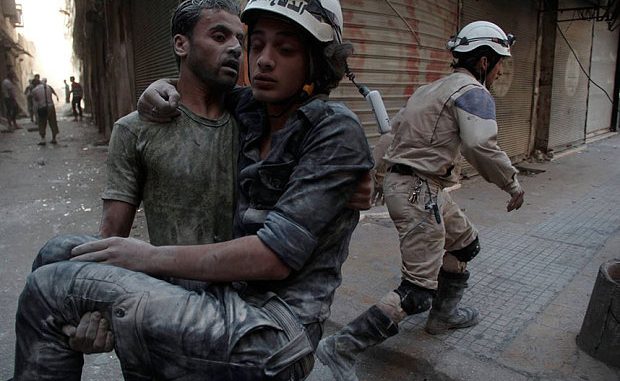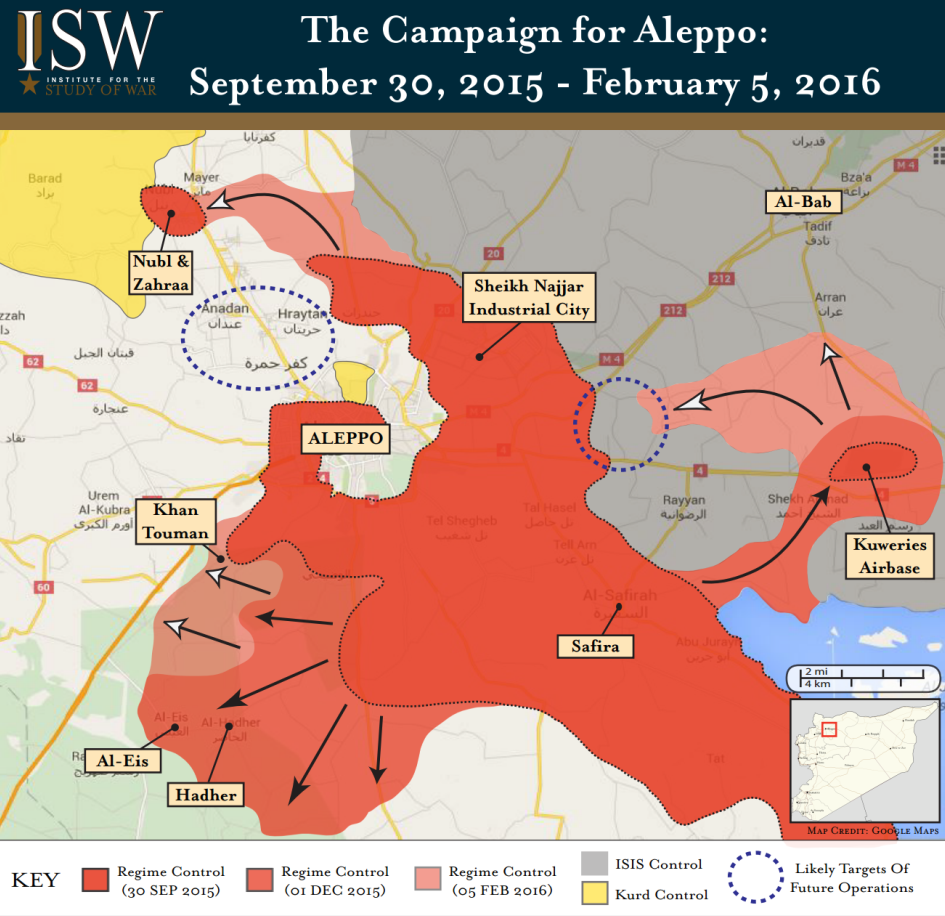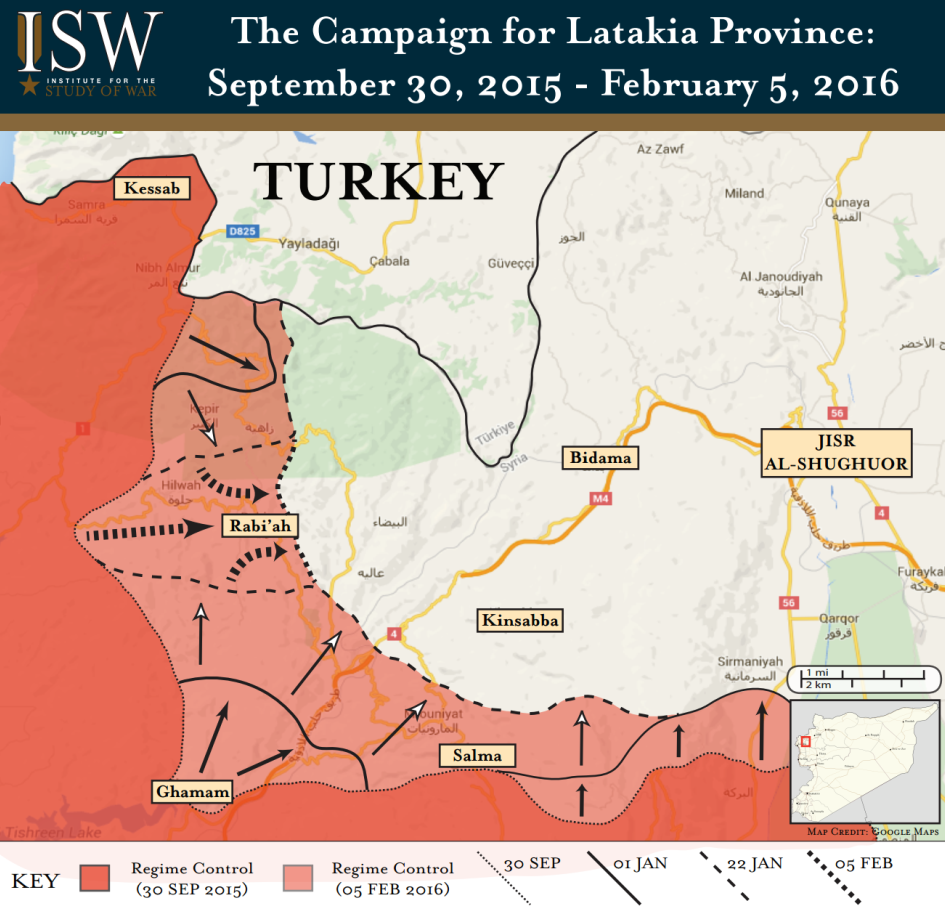
Manpower from Iran and bombs from Russia have enabled the Syrian troops to come within a few miles of encircling Aleppo.
Thousands are fleeing the area in fear of an impending siege.

BYPASS THE CENSORS
Sign up to get unfiltered news delivered straight to your inbox.
You can unsubscribe any time. By subscribing you agree to our Terms of Use
Latest Video
ISW reports:
Battlefield realities rather than great power politics will determine the ultimate terms of a settlement to end the Syrian Civil War.
Syrian President Bashar al-Assad and his allies in Russia and Iran have internalized this basic principle even as Washington and other Western capitals pinned their hopes upon UN-sponsored Geneva Talks, which faltered only two days after they began on February 1, 2016.
Russian airpower and Iranian manpower have brought President Assad within five miles of completing the encirclement of Aleppo City, the largest urban center in Syria and an opposition stronghold since 2012.
The current campaign has already surpassed the high-water mark set by the regime’s previous failed attempt to besiege Aleppo City in early 2015.
The full encirclement of Aleppo City would fuel a humanitarian catastrophe, shatter opposition morale, fundamentally challenge Turkish strategic ambitions, and deny the opposition its most valuable bargaining chip before the international community.
The campaign against Aleppo City began in October 2015 and proceeded in several phases. Regime forces enabled by Russia and Iran initially mounted probing attacks along multiple fronts in Aleppo and Idlib Provinces as part of a larger campaign designed to confuse and overextend the opposition.
They conducted shaping operations in the southern, eastern, and northern countryside of Aleppo City in order to draw opposition forces out of urban terrain, relieve long-besieged pockets of regime forces, and set conditions for a future decisive operation to besiege the city, as ISW warned on December 30, 2015.

They also secured core regime terrain along the Syrian Coast against further opposition attacks through a series of rapid offensives in Latakia Province. These gains marked a fundamental shift in battlefield momentum following dramatic losses experienced by the regime in the first half of 2015.
President Assad has used unconventional shaping operations to complement these ground offensives and further strengthen his bargaining position. The regime intensified its campaign of sieges and aerial bombardment against opposition-held pockets in Homs and Damascus Provinces in order to impose one-sided local ceasefires that would allow it to consolidate control in these two vital cities.
These operations in some cases included the use of chlorine gas and other unidentified chemical weapons in violation of international prohibitions. The regime also escalated a campaign of targeted assassinations against key opposition commanders – most notably the Saudi-backed Damascus powerbroker Zahran Alloush – in order to weaken the political influence of its opponents.
These gains strengthen the hand held by President Assad at the negotiating table and incentivize further violence among all sides in an attempt to secure additional concessions during an eventual settlement. The mounting pressure will tend to drive the opposition towards militarily reliable but politically irreconcilable Salafi-jihadist groups such as Syrian al-Qaeda affiliate Jabhat al-Nusra.
Conditions on the ground remain unsuitable for the achievement of any meaningful peace in Syria.
Aleppo Province
The regime and its allies have waged a multi-pronged campaign in Aleppo Province over the past four months to set conditions for an offensive to isolate and ultimately seize Aleppo City.
The opposition is uniquely vulnerable in Aleppo City due to its position along a lengthy salient that relies upon one primary ground line of communication (GLOC) that faces compounding pressures from the regime, ISIS, and the Syrian Kurdish YPG.
The return of the largest urban center in Syria to government control would represent a major victory for Syrian President Bashar al-Assad that would bolster his leverage in current or future political negotiations. A successful campaign for Aleppo City would also constitute a serious blow to the morale of opposition groups that have contested the city since mid-2012.
The operations in Aleppo Province have hinged upon heavy military support from both Russian warplanes and Iranian proxy fighters. Russia concentrated a significant portion of its air campaign against opposition forward positions and supply lines in Aleppo Province.
Meanwhile, U.S. officials estimated in October 2015 that up to 2,000 Hezbollah, Afghan, and Iraqi Shi’a militia fighters led by Islamic Revolutionary Guard Corps (IRGC) – Quds Force commander Maj. Gen. Qassem Suleimani currently operated in Aleppo Province.
U.S. officials also stated that Russian Spetsnaz special operations forces recently began operating in conjunction with pro-regime forces near Aleppo City. The regime has become increasingly dependent on this foreign support in order to conduct successful maneuver warfare.
Read more at: understandingwar.org/backgrounder/assad-regime-gains-aleppo-alter-balance


